"Spring is sprung, the grass is ris, I wonder where the birdies is!"
In other words, spring is here and the floral season is upon us. This blog post is about getting the most out of spring flowers looking at equipment, subject and composition. Close-up or macro photography is a fascinating sub-genre of nature photography that can give a lot of bang for the buck - you don't have to invest tons of money in expensive equipment to get some cracking results.
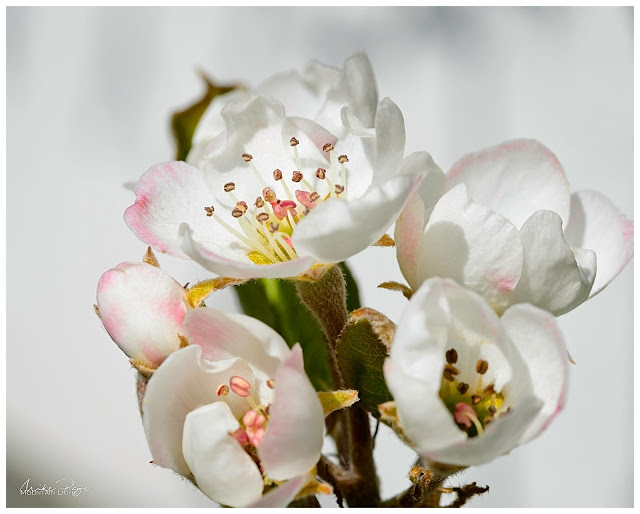 |
| Pear Blossom in my Garden || Olympus 60 mm, f/8, 1/400 s, ISO 200 |
I'm not going to go into complicated things like focus stacking or special lighting here, this post is going to be directed at beginners and enthusiasts - how to get stunning close-ups of flowers in the spring. For those interested in the technical background, the official definition of a macro photograph is one where the subject takes up the same amount of space on the camera sensor as in real life; this is a 1:1 representation of the subject. Anything lower than this is simply a close-up, from around the 5:1 level we're into microscopic photography.
The Equipment
Every lens has a minimal focus distance - the closest distance at which you can focus on an object. On a normal lens this will be somewhere between 20-50 cm, which is too far to get great shots of small subjects. But there are a couple of relatively inexpensive ways of reducing this, allowing you to get closer to your subject and allowing you to fill your frame with the beauty that nature provides. No-one is going to be interested in a shot of flower blossoms that fill 2% of your photo. The aim here is to get up close and personal with nature.
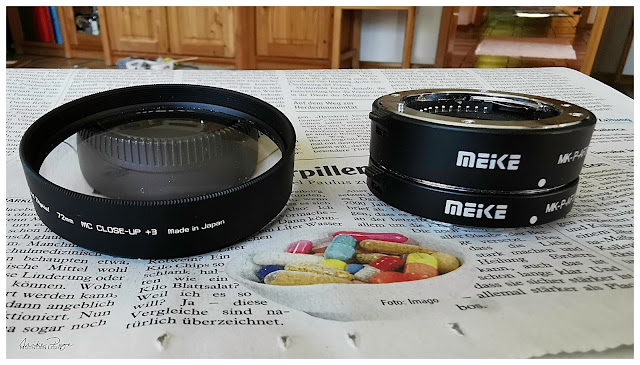 |
| Close-up Filter (l) and Extension Tubes |
The first tool I bought for close-up photography was a +3 diopter close-up filter for my standard M. Zuiko 12-100 mm lens that I use on my Olympus camera. This effectively functions as a magnifying glass screwed onto the front of your lens and allowing you to reduce the minimal focal distance. Plus 3 diopter allows you to get significantly closer, but be prepared to dig a little into your pocket for this. I just looked up how much this filter costs on the Big River website and was shocked to see that you'll need to spend around € 100 for one of these attachments at the moment. I'm sure I didn't spend that much when I bought mine, but for a number of years, this was my go-to tool, always in my camera bag in the mountains.
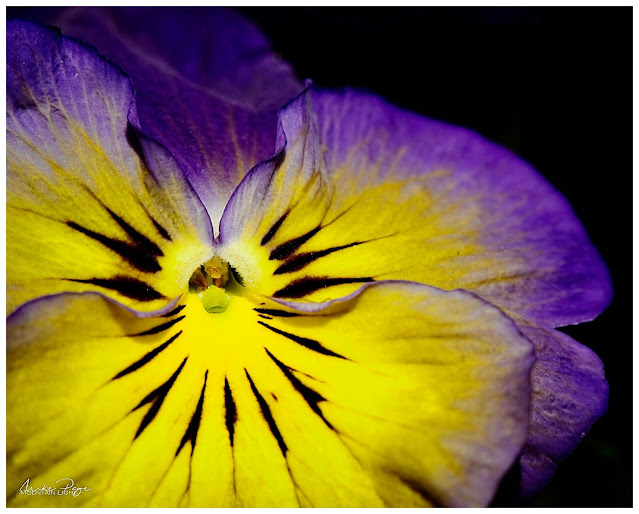 |
| Fill that Frame! Pansy close-up |
The next tool I bought was a set of extension tubes. These are essentially hollow tubes that are inserted between the lens and the camera. They don't contain any glass and so won't affect the quality of your photo in any way. Often they will provide connectors that allow your camera to continue to communicate with the lens for purposes of setting the aperture and focus. The tubes also allow you to get much closer to your subject as above. A set of tubes will set you back about € 30 (+/-). The length of the tubes shouldn't be longer than the focal length of your lens, otherwise you won't be able to focus.
If you're really serious about close-up photography you might want to consider investing in a dedicated macro lens. I recently bought the Olympus f/2.8 60 mm macro lens. It's so small that I can take it with me everywhere.
Normally, a tripod isn't necessary and a lot of macro photographers actually prefer not to use them. For standard shots I don't bother with one, only if I'm focus stacking or dealing with really small subjects.
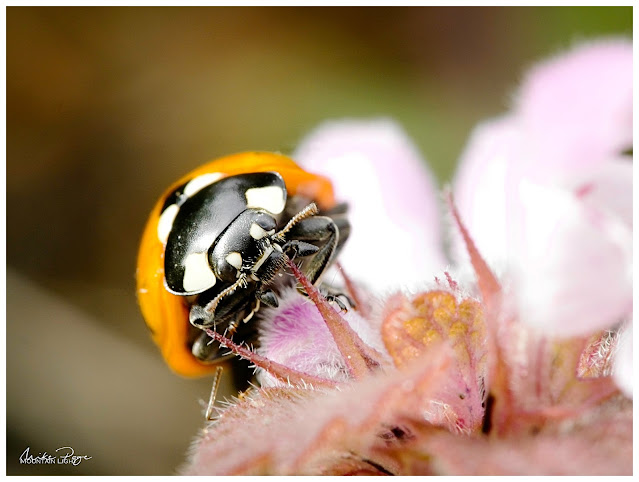 |
| Ladybird on Nettle Flower || Olympus 60 mm, f/8, 1/50 s, ISO 400 |
All of the above can also be combined and I've already used the extension tubes to great effect with my macro lens allowing me to get some really close up shots of garden insects such as the ladybird above.
The Subject
Not every flower works well close-up. Some look better as a group from a distance, get too close and they can be boring. Complex flowers like dandelions and daisies can look fantastic close up. Others can look just bleurgh... Trial and error is the best approach here. Blossom is nearly always good close up, as are catkins and pussy willow. Experiment and you'll find what works best for you.
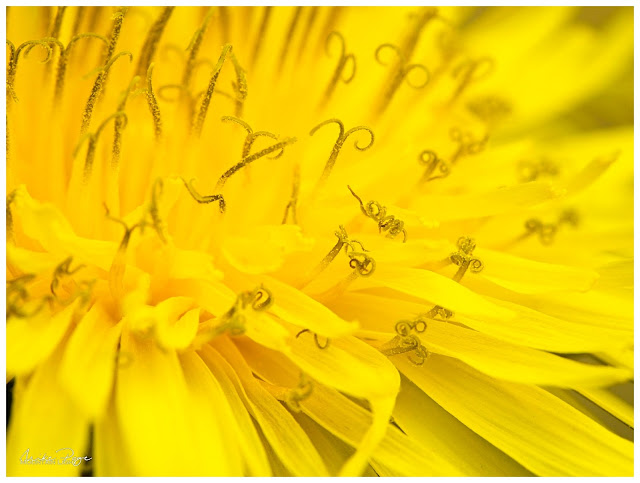 |
| Dandelion Detail || Olympus 60 mm, f/8, 1/100 s, ISO 400 |
One of the beauties of macro photography is that you don't need to go far to find your subject. If you have a garden or even just a balcony, you more than have plenty of subjects to hand. Otherwise, head out to a local park, or even better a botanical garden.
One of the things to bear in mind with close-up photography is that the depth of field gets shallower the closer you are to a subject. This can be both a boon and a bane. It can really isolate the subject matter using sharp focus on your subject whilst throwing the background (and foreground) pleasingly out of focus, but if the depth of focus is too tight you'll struggle to get all of you subject in focus.
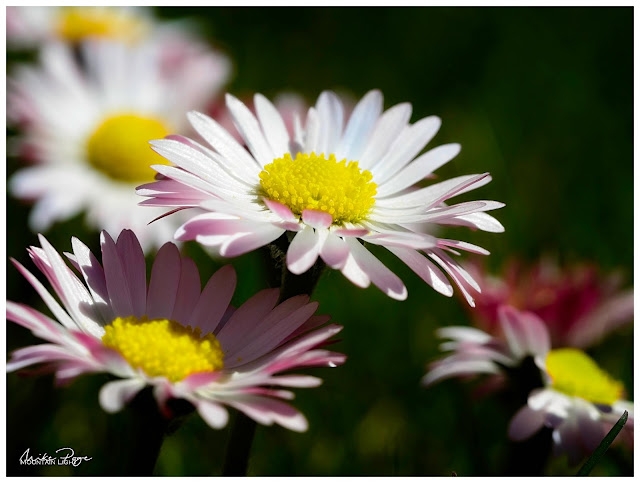 |
| Down among the Daisies || Olympus 60 mm, f/5.6, 1/1250 s, ISO 200 |
The depth of field (or depth of focus) describes the distance before and after the focal point that is acceptably in focus to the native eye. At it's shallowest, the subject is is in focus and the foreground and background are blurred. At it's broadest, focus will extend for most of the scene. In the shot of the daisies above, the depth of focus is restricted to the plane encompassing the yellow stamen of the central daisy flower. Everything in front of that and everything behind is out of focus.
Just like the exposure triangle (ISO/Shutter Speed/Aperture), there's a depth of field triangle:
Aperture - Focal Distance - Focal Length
The wider the aperture, the shorter the distance from the lens and the longer the lens, the shallower the depth of field:
| Shallower DoF | Wider DoF |
Aperture | Wider (lower number) | Narrower (higher number) |
Focal Distance | Closer | Further away |
Focal Length | Longer | Shorter |
The Composition
One of the great things about macro photography is it gives you to present your viewers with details that they perhaps hadn't consciously seen before giving rise to that cherished 'oh wow!' reaction. There are a couple of simple tricks to getting a cool close-up photo of flowers:
One of my favourites is to get low down to the flower, on your stomach in the grass if needs be (taking care not to squash other flowers and don't forget to check for ticks afterwards). This gives a much more interesting angle and view than looking straight down on the flowers, catching your shoes in frame. For greatest effect you need to be just above or below 90° - above allows a glimpse into the flower, below can be really effective against the light.
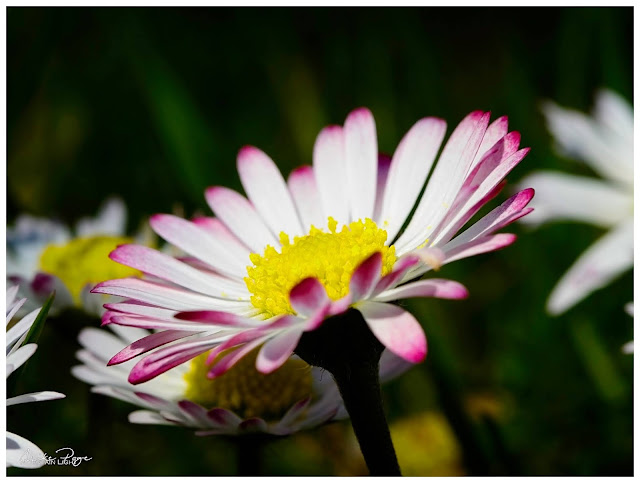 |
| Down at Daisy Level || Olympus 60 mm, f/8, 1/200 s, ISO 200 |
Another thing that's cool to do is to put the flowers in their context. The shot here of the crocuses isn't a close-up, but it puts them nicely in their context in the Allgäu mountains. The best way of doing this is with a wide angle lens, making sure to get close to your subject matter so it takes up a significant part of the frame whilst allowing the background to play a supporting role.
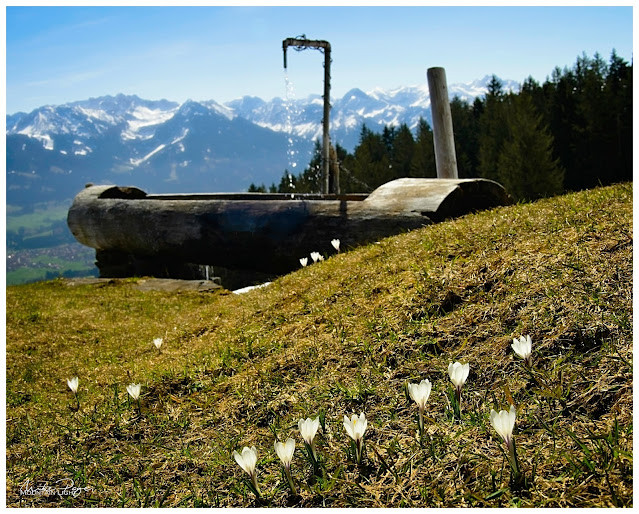 |
| Mountain Crocuses in Context || Olympus 18 mm, f/8, 1/320 s, ISO 200 |
With these primulas I included a bit of the stream to anchor them in their environment. Opening the aperture helped me to isolate the flowers and give the viewer a hint where they're supposed to look, important here given the lack of colour contrast between the flowers and the background.
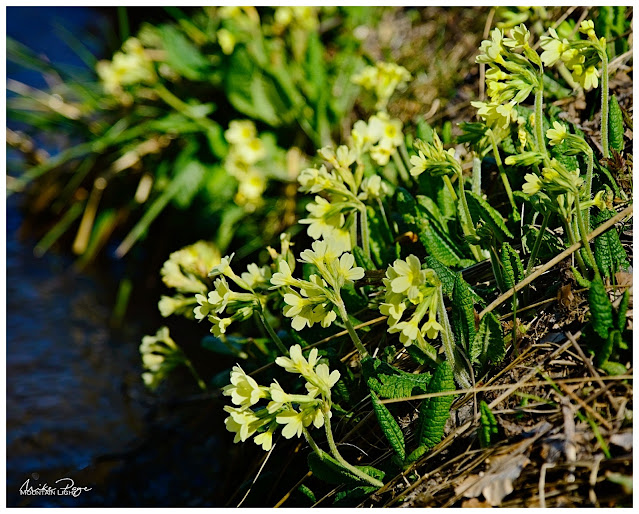 |
| Primulas at the Stream || Olympus 100 mm, f/4, 1/50 s, ISO 200 |
Where the flowers aren't necessarily very strong individually, back up a little and take them as a group - there's strength in numbers.
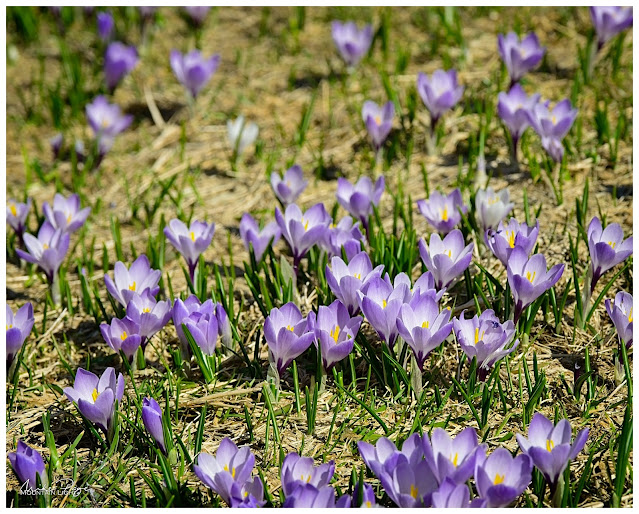 |
| Crocus Field || Olympus 80 mm, f/8, 1/320 s, ISO 400 |
When shooting tree blossom, diagonal branches can support the composition. Watch out for distracting elements in the background and try to get your focus on the closest part of the blossom for the biggest impact.
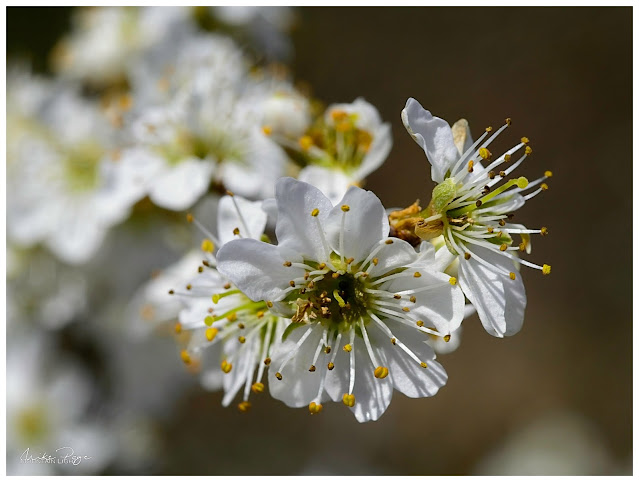 |
| Spring Blossom || Olympus 60 mm, f/8, 1/400 s, ISO 200 |
So, what's stopping you? Get out there, take some stunning spring photos and share them online!
Addendum: Light
I've just been out working in the garden and realised that I'd forgotten one of the most important aspects of photography: Light. Most of the time our instinct is (hopefully) to shoot with the light behind us or to the side. If we shoot into the light, often our subject will be a dark splodge and the background a washed-out blur. It hurts when I see people taking photos like this because I know they're going to turn out badly. Always know where the light's coming from and take it into account when you're taking photos.
The wonderful thing about flowers though is that they're often translucent - they let a certain amount of light through - as illustrated by this lovely photo by my friend Emma Marra. It also shows nicely the principle of shooting from slightly below the flowers and up towards the light. All the better if you can place something dark behind the flowers as here to let them really shine.
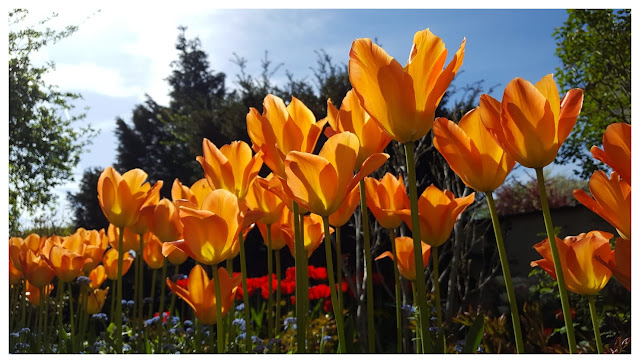 |
| Emma's Tulips. Down low and against the light. |
























































